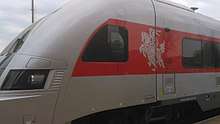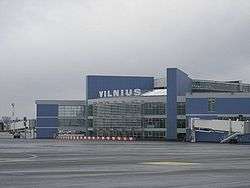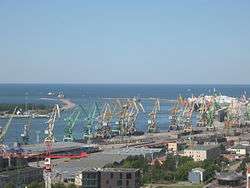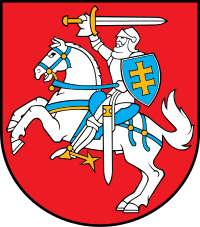Transport in Lithuania
Transport in Lithuania relies mainly on road and rail networks.
Lithuanian road system
.png)
(2018):
total:
21,238 kilometres (13,197 mi)
paved:
14,879 km (9,245 mi)
unpaved:
6,359 km (3,951 mi)
Highways
Controlled-access highways sections
There are two categories of controlled-access highways in Lithuania: expressways (Lithuanian: greitkeliai) with maximum speed 120 km/h and motorways (Lithuanian: automagistralės) with maximum speed 130 km/h.
Motorway sections
- A1 Kaunas - Klaipėda. Total length of the stretch: 195 km. The motorway ends for a short section near Sujainiai (Raseiniai district municipality) as the junction here is one-level and it is used by non-motorway vehicles.
- A2 Vilnius - Panevėžys. Total length of the stretch: 114 km.
- A5 Kaunas - Marijampolė. Total length of the stretch: 57 km.
Expressway sections
A road system
The A roads (Magistraliniai keliai) total 1,748.84 km (1,086.68 mi).
- A1 Vilnius – Kaunas – Klaipėda, 311.40 km (193.49 mi). Most important east to west corridor in Lithuania. Connects three largest Lithuanian cities: Vilnius, Kaunas and Klaipėda. The stretch between Kaunas and Klaipėda has motorway status.
- A2 Vilnius – Panevėžys, 135.92 km (84.46 mi). The stretch between Vilnius and Šilagalis has motorway status.
- A3 Vilnius – Medininkai Border Checkpoint, 33.99 km (21.12 mi). Continues to Belarus and connects Vilnius with the Belarusian capital of Minsk.
- A4 Vilnius – Raigardas Border Checkpoint, 134.46 km (83.55 mi). Continues to Grodno, Belarus.
- A5 Kaunas – Polish Border, 97.06 km (60.31 mi). The stretch from Kaunas to Marijampolė has motorway status. Continues towards Suwałki in Poland.
- A6 Kaunas – Daugavpils, 185.40 km (115.20 mi). Continues towards Daugavpils in Latvia.
- A7 Marijampolė – Kybartai Border Checkpoint, 42.21 km (26.23 mi). An important transit route to Kaliningrad Oblast.
- A8 Sitkūnai - Panevėžys, 87.86 km (54.59 mi).
- A9 Panevėžys – Šiauliai, 78.94 km (49.05 mi). Short 10 km expressway section.
- A10 Panevėžys – Bauska 66.10 km (41.07 mi). Continues to Bauska in Latvia. Important transit route to Riga.
- A11 Šiauliai - Palanga, 146.85 km (91.25 mi)
- A12 Latvian Border - Panemunė Border Checkpoint, 186.09 km (115.63 mi)
- A13 Klaipėda – Liepaja, 45.15 km (28.05 mi)
- A14 Vilnius – Utena, 95.60 km (59.40 mi)
- A15 Vilnius – Lida, 49.28 km (30.62 mi)
- A16 Vilnius – Marijampolė, 137.51 km (85.44 mi)
- A17 Panevėžys Bypass, 22.28 km (13.84 mi).
- A18 Šiauliai Bypass, 17.08 km (10.61 mi)
- A19 Vilnius Southern Bypass, 7.9 km (4.9 mi)
- A20 Ukmergė Northern Bypass, 7.7 km (4.8 mi)
- A21 Panemunė Eastern Bypass, 4 km (2.5 mi)
First Lithuanian-built highways
There were some isolated routes built before World War I, e.g. present-day A12, connecting Riga with Kaliningrad. First long-distance highways built exclusively by Lithuanian Government were opened in late 1930s:
- Samogitian highway - old highway built in 1930s, connecting Kaunas and Klaipėda. As for today, road section between Kaunas and Ariogala is completely refurbished to motorway. From Ariogala to Klaipėda, it serves as alternative road for a parallel-built motorway A1 and connects local towns such as Ariogala, Raseiniai, Rietavas.
- Aukštaitian Highway - old highway built in the 1930s. It connects Kaunas, Kėdainiai, Panevėžys and Biržai. Currently road is a part of land road 229 (Cinkiškiai interchange-Kėdainiai), Via Baltica (part from Kėdainiai to Pasvalys) and land road 125 (from Pasvalys to Biržai)
Museum
Railways


There is a total of 1,998 route km of railways, of which:
- 1,807 km are broad gauge of 1,520 mm (4 ft 11 27⁄32 in) – 122 km of which are electrified
- 169 km are narrow gauge of 750 mm (2 ft 5 1⁄2 in) – as of 2001
- 22 km are standard gauge of 1,435 mm (4 ft 8 1⁄2 in)
Rail links with adjacent countries
- Latvia - yes
- Belarus - yes
- Russia (Kaliningrad) - yes
- Poland - yes - break-of-gauge 1,520 mm (4 ft 11 27⁄32 in) / 1,435 mm (4 ft 8 1⁄2 in)
Waterways
There are 600 kilometres (370 mi) that are perennially navigable.
Pipelines
In 1992, there were 105 km (65 mi) of crude oil pipelines, and 760 km (470 mi) of natural gas pipelines.
Ports and harbours
River ports
Merchant marine
The merchant marine consists of 47 ships of 1,000 GT or over, together totaling 279,743 GT/304,156 tonnes deadweight (DWT).
Ships by type: Cargo 25, Combination bulk 8, Petroleum tanker 2, Railcar carrier 1, Refrigerated cargo 6, Roll on/roll off 2, Short-sea passenger 3.
Note: These totals include some foreign-owned ships registered here as a flag of convenience: Denmark 13 (2002 est.)
Airports

In Lithuania, there are four international airports:
- Vilnius International Airport
- Kaunas Airport
- Palanga International Airport
- Šiauliai International Airport
- Paved Runways : 9 in total
- over 3,047 m: 2
- 1,524 to 2,437 m: 4
- under 914 m: 3
- Unpaved runways : 63 in total
- 2,438 to 3,047 m: 3
- 914 to 1,523 m: 5
- under 914 m: 55

